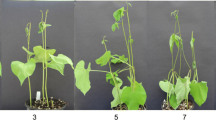Summary
Breeding of Phaseolus vulgaris L. for resistance to common bacterial blight (CBB) can be done with visual evaluations of symptoms to distinguish broad resistance classes, but a more quantitative measure was needed for genetic studies of resistance. A novel method of evaluation was developed by quantifying Xanthomonas campestris pv. phaseoli (XCP) in bean leaf tissue infected with CBB using a 32P-labeled probe and densitometric analysis of hybridization signals. Quantification of bacterial populations using the probe was highly correlated (r=0.98) with the number of colony forming units (CFU) from plate counts of the same leaf samples. The probe was used to follow XCP population dynamics on susceptible (BAT 41) and resistant (OAC 88-1) bean genotypes. OAC 88-1 supported a maximum XCP population which was approximately tenfold less than BAT 41. The probe was also used to study an F2/F3 population segregating for resistance. Narrow sense heritability estimates were less for resistance measured on the basis of bacterial populations (0.18–0.26) than on visual scores of symptoms (0.29–0.38). The anticipated response to selection for CBB resistance would be less based on bacterial numbers than based on symptom expression in this population. In breeding for resistance to CBB, selection based on visual symptoms combined with measurements of XCP populations using a DNA probe can be used to develop bean genotypes that are both resistant to symptom development and bacterial multiplication.
Similar content being viewed by others
Abbreviations
- CBB:
-
common bacterial blight
- CFU:
-
colony forming units
- XCP:
-
Xanthomonas campestris pv. phaseoli
References
Aggour A.R. & D.P. Coyne,, 1989. Heritability, phenotypic correlations, and associations of the common blight disease reactions in beans. J Amer Soc Hort Sci 114: 828–833.
Audy P., A. Laroche, G. Saindon, H.C. Huang & R.L. Gilbertson,, 1994. Detection of the bean common blight bacteria, Xanthomonas campestris pv. phaseoli and X. c. phaseoli var. fuscans, using the polymerase chain reaction. Phytopathology 84: 1185–1192.
Beaver J.S., J.R. Steadman & D.P. Coyne, 1992. Atypical symptom expression of common bacterial blight in tropical Pompadour germplasm. Ann Rep Bean Improv Coop 35: 110.
Beebe S.E. & M.A. Pastor Corrales, 1991. Breeding for disease resistance. In: A.van Schoonhoven & O. Voysest (Eds.). Common Beans: Research for Crop Improvement, pp. 561–617. CAB Intermational, Wallingford, U.K.
Cafati C.R. & A.W. Saettler, 1980. Effect of host on multiplication and distribution of bean common blight bacteria. Phytopathology 70: 675–679.
CIAT, 1987. Standard System for the Evaluation of Bean Germplasm. A. van Schoonhoven & M.A. Pastor Corrales (Compilers). CIAT. Colombia.
Coyne D.P. & M.L. Schuster, 1973. Phaseolus germplasm tolerant to common blight bacterium (Xanthomonas phaseoli). Plant Dis Reptr 57: 111–114.
Coyne D.P., M.L. Schuster & K. Hill, 1973. Genetic control of reaction to common blight bacterium in bean (Phaseolus vulgaris) as influenced by plant age and bacterial multiplication. J Amer Soc Hort Sci 98: 94–99.
Dhanvantari B.N. & R.J. Brown, 1993. YSSM-XP medium for Xanthomonas campestris pv. phaseoli. Can J Pathol 15: 168–174.
Drijthout E. & W.J. Blok, 1987. Inheritance of resistance to Xanthomonas campestris pv. phaseoli in tepary bean (Phaseolus acutifolius). Euphytica 36: 803–808.
Ferre F., 1992. Quantitative or semi-quantitative PCR: reality versus myth. PCR Methods Appl 2: 1–9.
Frey K.J. & T. Horner, 1957. Heritability in standard deviation units. Agron J 49: 59–62.
Gilbertson R.L., D.P. Maxwell, D.J. Hagedorn & S.A. Leong, 1989. Development and application of a plasmid DNA probe for detection of bacteria causing common bacterial blight of bean. Phytopathology 79: 518–525.
Gilbertson R.L., M.M. Otoya, M.A. Pastor Corrales & D.P. Maxwell, 1991. Genetic diversity in common blight bacteria is revealed by cloned repetitive DNA sequences. Annu Rep Bean Improv Coop 34: 37–38.
Goodwin P.H., J.T. English, D.A. Neher, J.M. Duniway & B.C. Kirkpatrick, 1990. Detection of Phytophthora parasitica from soil and host tissue with a species-specific DNA probe. Phytopathology 80: 277–281.
Goodwin P.H., C.R. Sopher & T.E. Michaels, 1995. Multiplication of Xanthomonas campestris pv. phaseoli and intercellular enzyme activities in resistant and susceptible beans. J Phytopathology 143: 11–15.
Pastor Corrales M.A., S.E. Beebe & F.J. Correa, 1981. Comparing two inoculation techniques for evaluating resistance in beans to Xanthomonas campestris pv. phaseoli. In: J.C. Lozano (Ed.). Proc. Fifth Int. Conf. Plant Path. Bact., pp. 493–503. CIAT, Colombia.
Sambrook J., E.F. Fritsch & T. Maniatis, 1989. Molecular Cloning: A Laboratory Manual, Second edition. Cold Spring Harbor Laboratory Press, New York.
Scott M.E. & T.E. Michaels, 1992. Xanthomonas resistance of Phaseolus interspecific cross selections confirmed by field performance. HortSci 27: 348–350.
Sheppard J.W., 1983. Historical perspectives of the production of disease-free seed, control and management of bacterial blights of beans in Canada. Seed Sci Technol 11: 885–891.
Silva L.O., S.P. Singh & M.A. Pastor Corrales, 1989. Inheritance of resistance to bacterial blight in common bean. Theor Appl Genet 78: 619–624.
Smith J.D. & M.L. Kinman, 1965. The use of parent-offspring regression as an estimator of heritability. Crop Sci 5: 595–596.
Thomas C.V. & J.G. Waines, 1984. Fertile backcross and allotetraploid plants from crosses between tepary beans and common beans. J Hered 75: 93–98.
Valladeres Sanchez N.E., D.P. Coyne & R.E. Mumm, 1983. Inheritance and associations of leaf, external, and internal pod reactions to common blight bacterium in Phaseolus vulgaris L. J Amer Soc Hort Sci 108: 272–278.
Weller D.M. & A.W. Saettler, 1980. Colonization and distribution of Xanthomonas phaseoli and Xanthomonas phaseoli var. fuscans in field-grown navy beans. Phytopathology 70: 500–506.
Author information
Authors and Affiliations
Rights and permissions
About this article
Cite this article
Caroline Constabel, E., Michaels, T.E., Goodwin, P.H. et al. Evaluation of a DNA probe for the quantitative detection of common bacterial blight in common bean and its application in a breeding program. Euphytica 90, 129–135 (1996). https://doi.org/10.1007/BF00023851
Received:
Accepted:
Issue Date:
DOI: https://doi.org/10.1007/BF00023851




